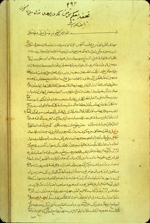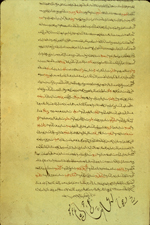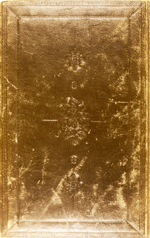Catalogue: Pharmaceutics
 A Note on Tuḥfat al-mu’minīn
A Note on Tuḥfat al-mu’minīn
This treatise is a comprehensive pharmacopoeia of simple and compound remedies, composed, according to the author, as a corrective to the Persian pharmacopoeia titled Ikhtiyārāt-i Badī‘ī by Ḥājjī Zayn al-‘Aṭṭār (MS P 9). The treatise was dedicated to Shah Sulayman, the Safavid ruler of Persian from 1666 to 1694.
Tunakābunī's treatise is described in the preface as having two major sections: a tashkhisat and a dasturat. The tashkhisat is subdivided into five subsections, each called a tashkhis, concerned with: (1) the reasons for differences of opinion amongst physicians regarding the nature and quantity of dosages, (2) the functions of medicaments, both simple and compound, (3) the properties (khawass) and nature of simple and compound remedies, the longest of the chapters incorporating a detailed alphabetical list of medicaments and their synonyms in various languages [i.e., Indian dialects, Arabic, Turkish, and Persian], (4) the treatment of poisons, and (5) weights and measures. The dasturat is stated to consist of three parts (qisms) concerned with (1) the uses of simple drugs, (2) the uses of compound remedies, and (3) the treatment of diseases. This final section, on the therapy of diseases in general, is lacking in all the copies that have so far been recorded.
NLM has a copy made in 1803/1218 of the first three tashkhises (MS P 21), a second copy that contains the alphabetical drug list forming part of the third tashkhis as well as the 4th and 5th tashkhis and the first two parts of the dasturat (MS P 22), and an Arabic translation of the first three tashkhises, in the handwriting of the translator, completed on 2 Muharram 1166 (= 9 November 1752) by Muṣṭafá Dars ‘Ām Yūsuf Zādah al-shahīr bi-al-Shirwānī (MS A 42). No other copy of this Arabic translation has been identified.
For other copies of the Persian treatise,see Storey PL II,2, pp. 261-3 no. 448; Richter-Bernburg, "UCLA", pp. 128-38, nos. 115-122; and Keshavarz, "Wellcome" p. 268-274 (17 copies); ‘Adnan al-Zu‘mah, Die arabischen Handschriften der Universitätsbibliothek Marburg (Marburg: Universitätsbibliothek Marburg, 1979), pp. 284-5 no. 364, copied in 1767/1181. The text was lithographed under the title Tuhfa-i Hakīm Mu’min in Teheran in 1860 and in Isfahan in 1857.
Illustrations
The beginning of an incomplete copy of the Tuḥfat al-mu’minīn, a popular Persian pharmacopoeia by Tunakābunī which he dedicated to Shah Sulayman, the Safavid ruler of Persian from 1666 to 1694. This copy contains only the first three portions of the first section of the treatise. The copy was completed by an unnamed copyist on 16 Safar 1218 (= 7 June 1803). It is written on a paper dyed a light shade of green, and a later reader has written at the top, in large script, that it is the Tuḥfat of Hakīm Mu’min [Tunakābunī] dedicated to Shah Sulayman.
The last page, with colophon, of an incomplete copy of the Tuḥfat al-mu’minīn, a popular Persian pharmacopoeia by Tunakābunī which he dedicated to Shah Sulayman, the Safavid ruler of Persian from 1666 to 1694. This copy contains only the first three portions of the first section of the treatise. At the bottom of the page it is stated that the copyist, who is not named, completed the copy on 16 Safar 1218 (= 7 June 1803). A later hand has written the date a second time in very large script at the bottom of the page. The copy is written on a paper dyed a light shade of green.
This Persian/Turkish binding of the 17th or 18th century is made of black leather over pasteboards. Both covers have a deeply stamped ovoid medallion with pendants, scalloped and with internal floral designs. The design is framed by a single fillet surrounded by a wider frame of fillets filled with leaf-like S-stamps.
Physical Description
Persian. 224 leaves (fols. 2b-225b). Dimensions 31.3 x 18.5 (text area 24.5 x 12.5) cm; 28 lines per page. The title is given in the preface (fol. 3a, line 18), and the author is named in the preface (fol. 2b, lines 15-18) as Muḥammad Zamān Tunakābunī Daylami Muḥammad Mu’min Ḥusaynī tabib [the physician].
The copy is dated in the colophon (fol. 225b, line 28) the 16th of Safar 1218 (7 June 1803). The copyist is not named.
The volume consists of 227 leaves. Fols. 1ab, 2a, 226b, and 227ab are blank. The lower two-thirds of fol. 9a is left blank, with no apparent break in the text from 9a to 9b.
The copy contains only the first three subsections of the first book (tashkhisat): the first tashkhis begins on fol. 3b, line 4, the second on 5a, line 10, and the third on 8b, line b.
The text is written in a small to medium-small naskh tending toward ta‘liq script, compact, careful, and consistent. Several hands, though rather similar, have composed the copy. It is written in black ink with headings in red. The text area has been frame-ruled. There are catchwords.
There are marginal corrections, often by the copyist, and some other marginalia in various hands. At numerous points the text has been erased or crossed out, with the text often then overwritten in a much smaller hand (see, for example, fols. 35b, 40b, 80b, 85b, 90b, 98b, 103a, and 125a).
The thick, semi-glossy, paper has been dyed green. It has horizontal laid lines, single chain lines, and large, elaborate watermarks (crown with a wreath, initials). The edges of the leaves have been trimmed from their original size.
Binding
The volume is bound in a Persian or Turkish binding of the 17th or 18th century made of black leather over pasteboards. Both covers have a deeply stamped ovoid medallion with pendants, scalloped and with internal floral designs; there is a frame of a single fillet surrounded by a wider frame of fillets filled with S-stamps. There are dark-red paper pastedowns and no endpapers.
Provenance
It was in the collection of the Army Medical Library by 1946; no further information is available on provenance.
Owners' notes found on fol. 2b (top), fol. 225b (bottom) and fol. 226a, but they do not contain dates or owners' names.
References
Schullian/Sommer, Cat. of incun. & MSS., P 21, p. 336.
NLM Microfilm Reel: FILM 48-136 no. 1













